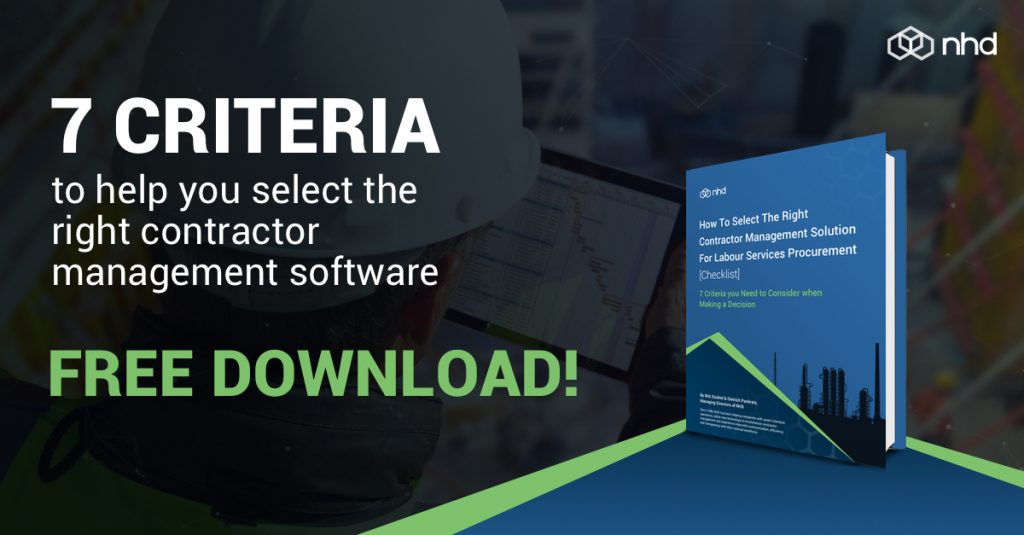Challenges in Holistic External Labour Management in Asset-Intensive Industries
Asset intensive companies, such as those in the automotive, chemicals, aviation, and oil and gas industries, have some of the largest utilization of external labour on a global scale.
Complex service agreements, high-volume contracts, and staff augmentation/ contingent labour can easily make up more than half of the total labour performing work for asset-intensive companies. Yet, there remain major challenges to holistic management of external labour in these industries.
How can this be possible when the asset-intensive industries also represent some of the largest global spend for external labour?
This blog post will explore the challenges that asset-intensive companies often face when it comes to gaining visibility and management of their external labour workforce and why Vendor Management Solutions (VMS), the most commonly offered technology to gain visibility and management of external workers in this space, are not adequately meeting these challenges.

The Challenges
Asset-intensive companies operate in a world of complex service agreements for capital projects, high-cost equipment and service rentals, risky and fast-paced operations such as turnarounds and maintenance that require large volumes of workers, and large-scale projects operating under a whole host of task and rate structures.
The biggest challenges for these companies in managing external labour arise from having a higher scrutiny on health and safety standards, dynamic rate agreements with a mix of unit and standard rate structures, and flexibility in managing service titles, equipment, and pay structures that can be different for the same external worker engaged in an asset-intensive company each day of the week.
In addition, it is extraordinarily important for asset-intensive companies to have strong relationships with their suppliers, service workers, and other externals as any disruption in what these groups provide can easily lead to costly shutdowns and a loss of business.
Engaging with providers who cannot complete their agreed-upon tasks could be a major issue as external services for asset-intensive companies are often core to the overall operation and work would be crippled without their seamless engagement.
With this, companies in this space often have the goal of creating strong partnerships with their suppliers, service providers, and contract workers. They also tend to create strong goals for health and safety standards, certifications, and quality.

The biggest overall challenge to the visibility and management of external labour in the asset intensive industries is simply that there are not any large-scale solutions on the market catering to the whole of their external engagements to the same degree as what the non-asset intensive companies have from solutions like VMS providers.
In most cases, companies in the asset intensive industries are utilizing several solutions such as ERPs, VMS, Contract Management Tools, and Asset Tracking Software to cover visibility of their external worker spend, but those solutions only individually cover portions of complex external labour management and are often difficult to piece together into a holistic technology ecosystem.
ERPs will allow the tracking and management to some degree of external labour using service entry sheets or statements of work, but they often do not provide any comprehensive coverage of worker management without a ton of workarounds.
Contract Management Tools will allow the quotes, negotiation, and supplier engagement tied to complex services, but also will not provide comprehensive external labour coverage.
Asset Tracking software will often provide coverage of external services through suppliers in conjunction with rentals, but outside of providers such as AES/32 you will not see much in terms of actual external worker tracking. So that leaves the VMS – the solution designed to procure and manage external workers – as the primary solution to cover what the other tools do not in acquisition and talent management.
Now, it is true that the major VMS providers have in the last couple years built in components to start rising to the needs in these industries, but their core focus and what they provide to the asset-intensive world is still majorly lacking.
Companies outside of asset-intensive industries may have some of these same components to a much lesser degree, but their challenges are not usually as severe. Primary concerns for companies in this group tend to center around worker cost, quality, and engagement speeds. Finding the right worker for the right cost and getting them on assignment in an appropriate time frame are the core components that have led software providers to create the VMS.
With these goals, suppliers are often evaluated in their ability to deliver against cost, worker quality, and time metrics, along with being rated for their service negotiations and delivery. When suppliers or workers are not performing against a company’s goals they are often replaced with minimal risk or damage to the business.
When comparing the common problems in gaining visibility and management in the asset intensive industries with the non-asset intensive industries, it is apparent that the goals and challenges of both are different.
Does VMS Make Sense for Holistic External Workforce Coverage in Asset-Intensive Industries?
VMS providers most often approach the external workforce through the lens of their core offering, contingent labour, and apply the management solutions catered to this specific group onto the other external workforce groups. In other words, the high focus on the ‘who, what, why, and how’ surrounding the individual workers in the contingent world are now being applied by VMS to external labour such as service providers and high-volume workers where the ‘who and why’ don’t necessarily matter as much as the ‘what and how’.
In some ways this has added benefit to the highly volatile world of external labour by providing solutions for lack of visibility, improved cost controls, and better understanding of quality in suppliers and external workers. In other ways this contingent-centric lens has hindered VMS providers in their ability to truly deliver solutions that simplify management of the other external workforce groups, such as managed services and contractors, that often have a higher emphasis on the supplier relationship than the individual workers.
This practically plays out with application features that offer companies the ability to see a vast amount of detail about each individual worker, such as rate history and locations worked, but does not easily allow the ability to see a history on the quality and safety of service work provided or metrics for equipment location, usage, and quality from the service providers.
VMS application features also offer the ability to set up dynamic rates and a range of payment types, but they do not offer unit rate management or the ability to switch a worker across jobs and pay scales from one day to the next without a whole host of custom configuration.
These features boil down to worker-centric models of engagement that benefit contingent labour vs. supplier-centric models of engagement that benefit asset-intensive services and contractors.
In Conclusion
Asset intensive industries are entrenched in complex and expensive service agreements for rentals, service workers, and services alongside a whole host of big dollar projects that employ various types of external workers and payment agreements.
As noted above, disruption to the supplier agreements and services in this space can be insanely costly and even detrimental to an asset-intensive business. Because of this the metrics and software needs for the asset-intensive industries are different than those outside of this space.
In many cases the service agreements with suppliers make up a significantly larger proportion of the external labour than contingent labour, and yet VMS providers are routinely being offered up as the holistic solution to manage all types of external labour for asset-intensive companies. While they absolutely could rise to the challenge in holistic external management in this space, it is very likely they are many years away from this being a reality.
So, what options do asset-intensive companies have to gain better visibility into their external workforce – from contingents to high-volume labour to contractors?
In the next blog post we will cover a deeper dive into solutions such as AES/32 and what they can provide to better bridge the gap of external workforce management in the asset intensive industries.
About NHD
For over 20 years, NHD has been providing an intelligent, all-in-one solution that bridges the gap between your company and your external workforce in the full source-to-pay cycle.
- Integrated communication processes with suppliers; from demand to payment
- Full worker profile visibility and management including certification and documentation tracking
- Quotation process supported by approved unit rate catalogues
- Effective time management with integration into gate systems
- Provides 100% contract compliance through standardized catalogues
- Dynamic auditing for process and rate compliance
- In-depth reporting and analytics for fatigue management, earned value management, contractor/site performance, and more
- Seamlessly integrates with SAP ERP/S4/Hana and more
Let's Chat.
Discover how our software is transforming contractor management. Contact us today.
Tired Of The Lack Of Transparency In Your External Spend?
Keep your business running smoothly with transparent labour and service procurement.
Simplify all tasks related to the management of the external workforce.





